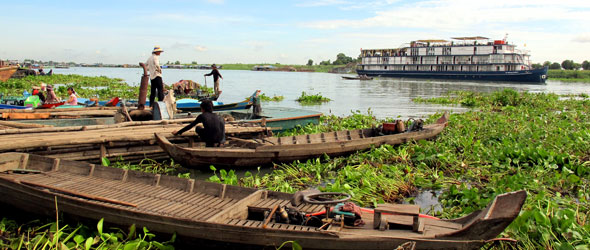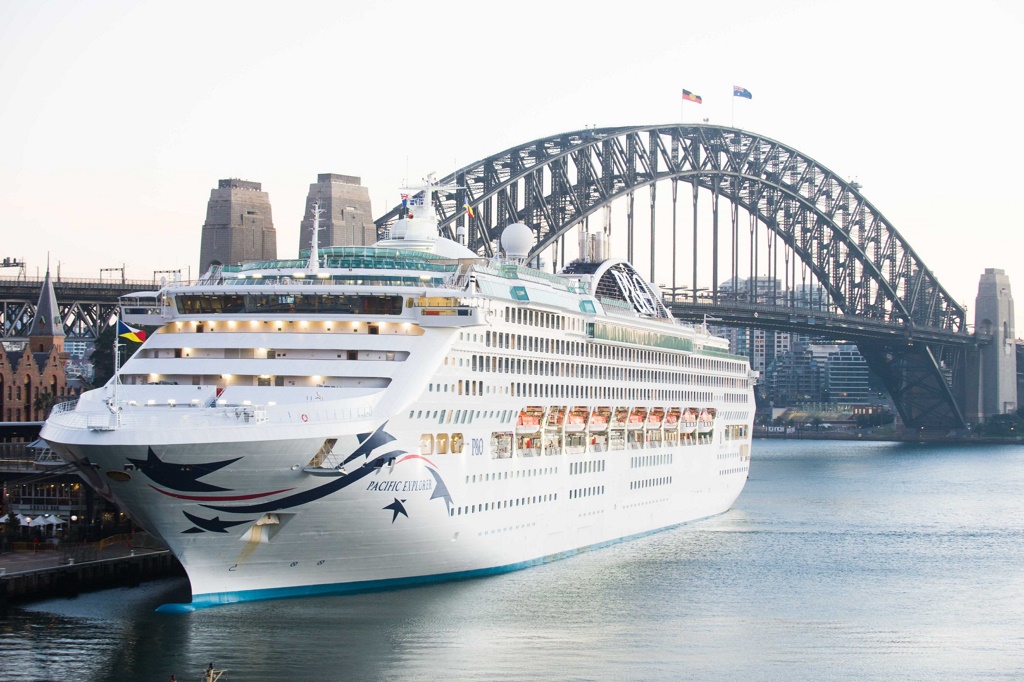Our seasoned expedition cruiser finds that South-East Asia’s busiest waterway still has room for adventure – and a little bit of luxury. Words & Photos: Roderick Eime
Close your eyes and say “Mekong” softly under your breath. Now, before someone thinks you’ve had too much tropical sun, tell me what you see. If you said “a wide bustling river bordered by lush undergrowth, with busy locals pushing their sampans under a balmy South-East Asian sun”, you’re on the money.
The Mekong is the dominant river of South-East Asia, running like a great life-giving artery down the curved spine of what was once French Indochina. The fertile lands bordering the river have been the objective of warring dynasties for centuries, and only over the past couple of decades has the region experienced relative peace.
With Communist, one-party Vietnam settling into a productive market economy and Cambodia recovering from the catastrophic upheaval of the 1970s, the region is attracting a bounty of tourists to this once mysterious part of the world – and by all accounts, the locals are pleased to see us. In the past decade, the fleet of cruise vessels plying this major waterway has expanded exponentially in line with tourism numbers. And those vessels have been quickly badged and branded by the major players from the world’s river cruising industry. For my Mekong expedition, I am aboard Heritage Line’s RV Mekong Explorer, better known by its marketing appellation, The Jayavarman, a name derived from the dynasty of famous Khmer rulers.
To look at her, she doesn’t appear the epitome of haute design, instead modelled on traditional Asian river boats and inspired, it is claimed, by the French ocean liner Normandie – but I’ll let you decide on that. Beneath her frumpy exterior is a stylish fit-out harking back to the early days of river cruising, complete with faux brass desk clocks and retro bathroom fittings. Along with matching public spaces, it creates a nostalgic atmosphere and sets the mood for our journey back in time, to when the Mekong was alive with this style of watercraft.
Each morning begins with tai chi (so I’m told) and the dining experience is much lauded by all aboard. Typically, it consists of delicately prepared local favourites such as fish and rice, with western alternatives and lots of delicious salads. Serving alternates between buffet and plated dishes, accompanied by wines from a small but well-chosen list. You can even get a decent coffee (but have to pay for it after breakfast).
The aquatic journey begins in the delta port of My Tho, a short coach ride from our hotel in downtown Saigon. Lined up along the wharf are the Pandaw Mekong and La Marguerite, vessels that share the premium category with The Jayavarman and will play Mekong tag with us on our voyage upstream.
Our first stop is Cai Be, a traditional trading port, where we cruise in our local sampan among the many vendors’ boats in the floating market. Fish, vegetables, rice and household items adorn the merchant boats, each advertising its trade with an item stuck to a pole and thrust into the air. On this early part of the trip, aided by excellent guides, we discover the many traditional industries – rice paper-making, weaving, fish farming and even brick-making – that have been carried on here for centuries.
We cross the border at Chau Doc, a thriving market town with tiny alleyways, lined with everything from meat and fish chopped on the spot to T-shirts and plastic pots. The town tour is enhanced by a rickshaw ride and there’s time to kill as our paperwork is laboured over by border officials.
Once we’re in Cambodia, the pace of life changes immediately. The Khmer people do not share the frenetic urgency of their Southern Vietnamese neighbours and we are greeted serenely by locals all along the river. The ubiquitous red scarves of the villagers remind me of the infamous Khmer Rouge, the ranks of which were filled by poor folk from villages such as Angkor Ban,
a hamlet that retains much of its traditional lifestyle.
We arrive at Phnom Penh early and as this is my fourth visit to the city, instead of revisiting the mandatory sights of the museums and Killing Fields, I catch up with my movie star pal, Kem (Srah) Sereyvuth. I met Srah while researching a story on a previous trip and, like so many of the older locals, he has harrowing tales of survival and loss under the Khmer Rouge. Srah was picked from a throng of clamouring hopefuls to play the part of a cyclo rider in Matt Dillon’s gritty 2002 thriller, City of Ghosts, starring himself, James Caan and Gerard Dépardieu, and filmed amid the hurly-burly and dust of Phnom Penh’s crumbling back streets. Today, Srah runs a small taxi business and occasionally guides tours for movie buffs. I’m delighted to learn that Dillon still stays in touch and flicks him work occasionally.
Back on board The Jayavarman, we complete our exploration with a foray farther up the Mekong and its tributary, Tonle Sap. There’s insufficient volume in the lake to get us to Siem Reap, so we make the final few hours by road, taking in a few interesting spots along the way including a truck stop that serves fried cricket, spider and cockroaches. Not a highlight for me: you might prefer high-water season, August to mid-December.
Though it’s not a formal part of your cruise itinerary, it stands to reason that you will linger in the now-sprawling township of Siem Reap to explore the UNESCO World Heritage-listed icon Angkor Wat. Give yourself plenty of time, at least a couple of days, and take in the splendour of this magnificent monument.
In summary, a Mekong cruise is a vital addition to the ‘brag bag’ of any serious river cruiser. The ships in this segment are all superb and are well supported by specialist agents and retailers.
HIGHS
• Superb vessel, crew and guides
• Delicious local cuisine on board
• Enriching shore excursions
LOWS
• Bus ride to Siem Reap
• Some cabin issues (hot water, air-conditioning)
FACT FILE
Cruise line: Heritage Line
Vessel: MV Mekong Explorer (aka The Jayavarman)
Max. Passenger Capacity: 54 in 27 staterooms
Total crew: 40
Passenger decks: 4
Entered service: 2009
Facilities: Restaurant, lounge/theatre/library, boutique, bar/lounge, sundeck, spa, free wi-fi.
BOOKINGS
Contact Active Travel (02 9264 1231; www.activetravel.com.au) or Travel Indochina (1300 362 777; www.travelindochina.com.au). Thai Airways flies 40 times a week to Bangkok from Australia with daily connections to Saigon (www.thaiairways.com.au). From Siem Reap, fly with Bangkok Airways (www.bangkokair.com) or Vietnam Airlines (www.vietnamairlines.com). Eight-day ‘Lost Civilisation’ cruise from US$2,426 per person, twin share.








